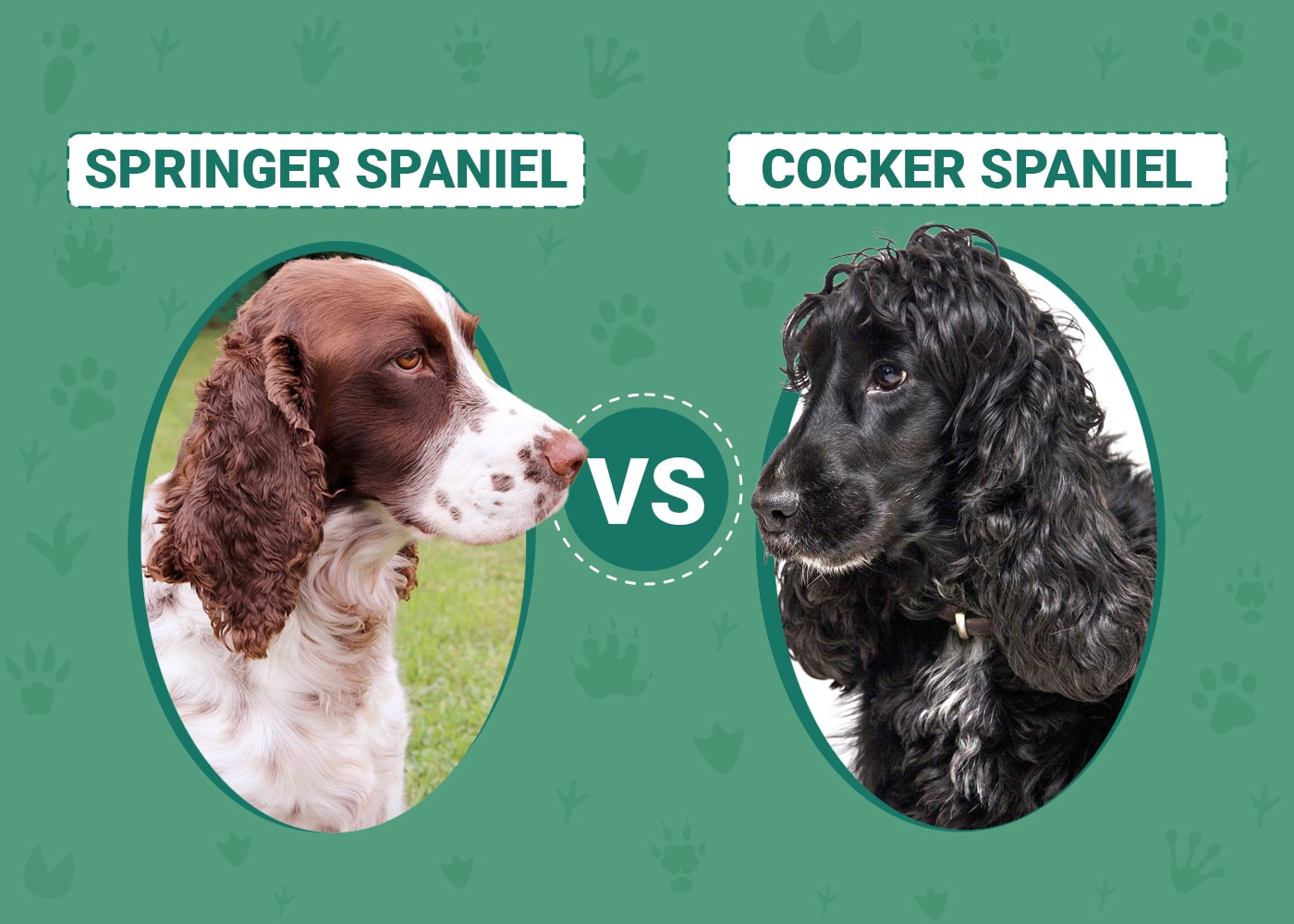Are you looking for an affectionate, intelligent, energetic, and gorgeous dog? If so, the Springer Spaniel and the Cocker Spaniel fit the bill almost perfectly. Both breeds are beloved in the United States for their gentle nature, high energy levels, and big, beautiful eyes.
These two popular working dog breeds are easy to train, have long, floppy ears, and make great pets and companions. They also look quite similar, and you’d be forgiven for mistaking one for the other if you weren’t an expert on the two breeds.
There are several differences between the Springer and Cocker Spaniel that you need to know before you make your final choice. To discover those differences and learn much more about these wonderful dogs, read on!
Visual Differences
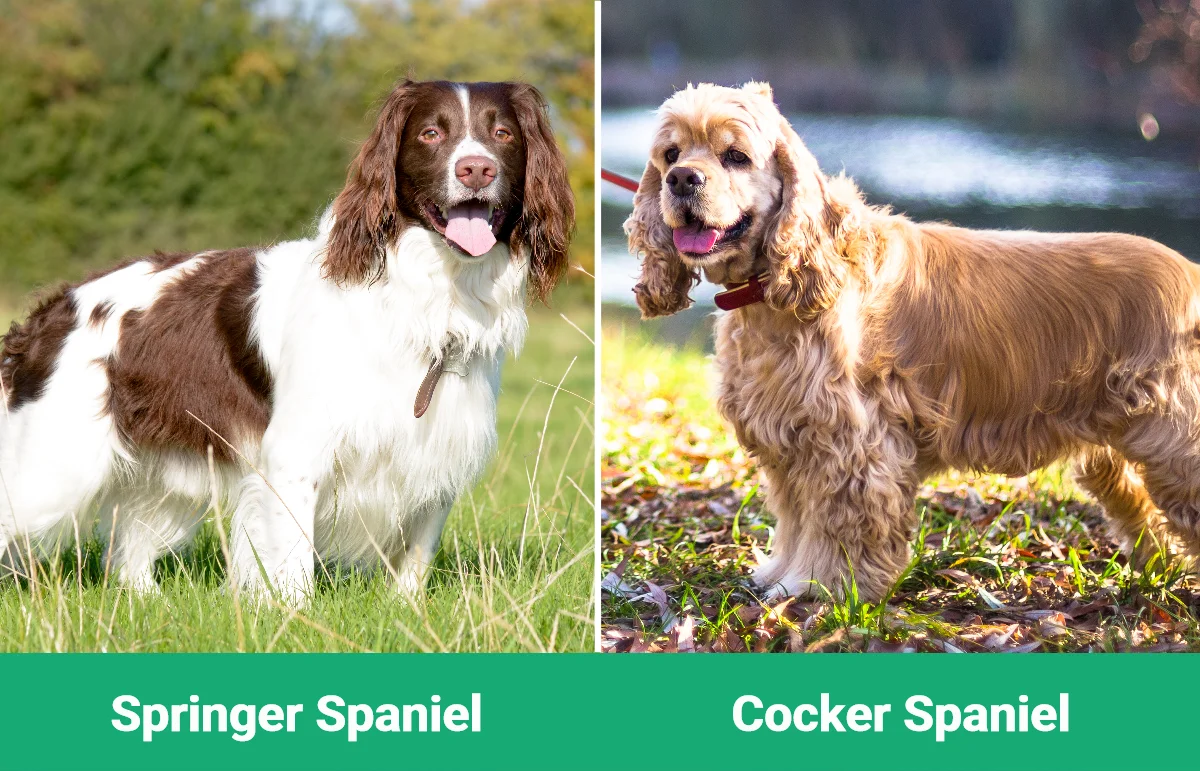
At a Glance
- Average height (adult): 18–20 inches
- Average weight (adult): 40–50 pounds
- Lifespan: 12–14 years
- Exercise: 2+ hours a day
- Grooming needs: Moderate
- Family-friendly: Yes
- Other pet-friendly: Usually
- Trainability: Highly intelligent, people pleasers
- Average height (adult): 13–16 inches
- Average weight (adult): 20–30 pounds
- Lifespan: 10–14 years
- Exercise: 1.5+ hours a day
- Grooming needs: Moderate to high
- Family-friendly: Yes
- Other pet-friendly: Yes
- Trainability: Intelligent, willing, easily distracted
Springer Spaniel Overview
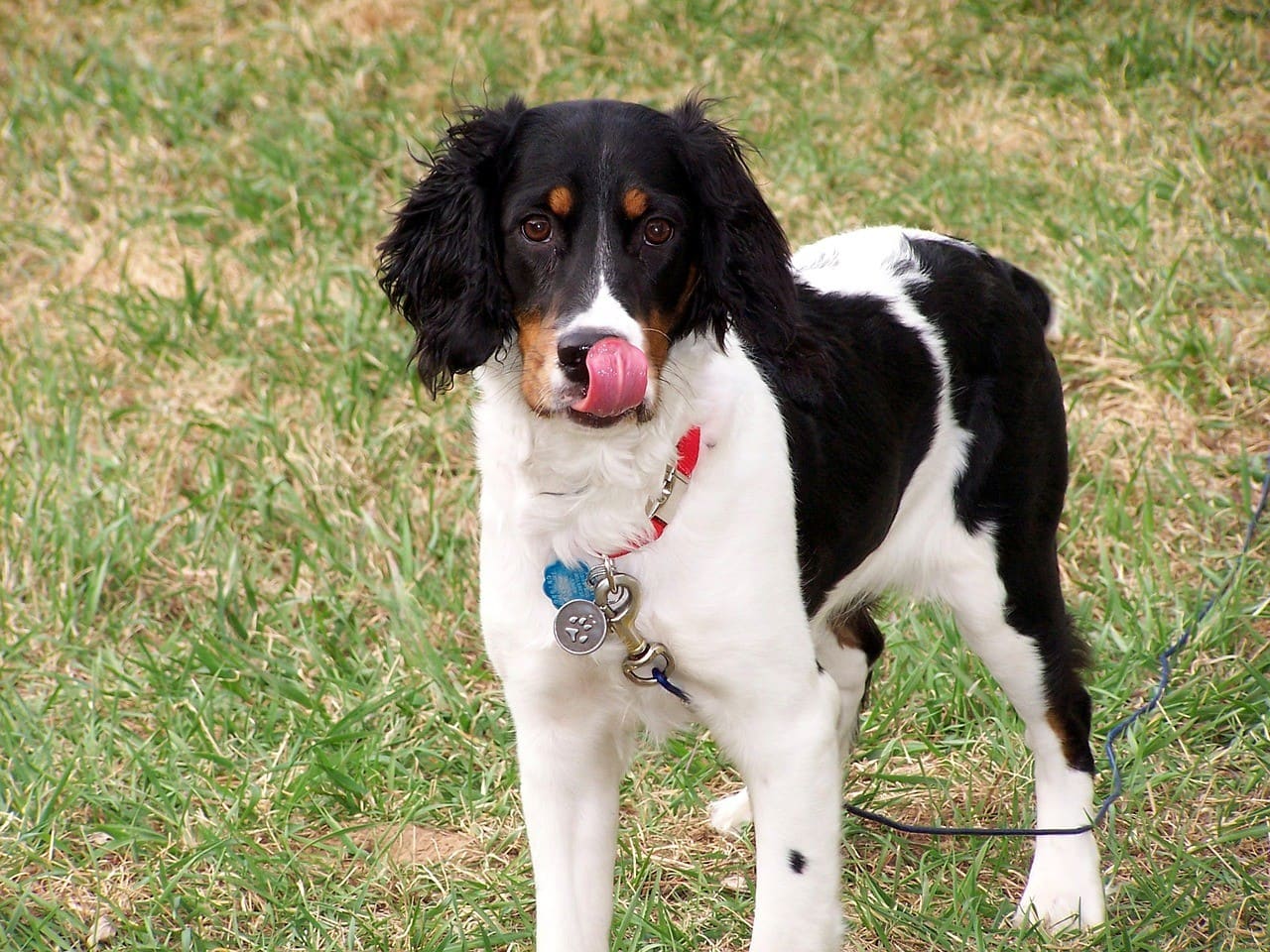
Personality / Character
Few dogs are as energetic and friendly as the Springer Spaniel. They are quintessential “Velcro dogs” that love being around their families and also love it when they have a job to do. Springer Spaniels are highly intelligent and, when raised with children, can be affectionate and patient with them. They also like being around the water, and some love it. However, they can become destructive if they get bored and need a fair amount of mental and physical stimulation to prevent that.
Training
It’s ideal to start training your Springer Spaniel as soon as you bring them home. By 6 to 7 months, they will already have developed poor habits and can be more than a bit stubborn. You can send your Springer Spaniel to puppy obedience school, but a dedicated owner might not find that necessary. It’s also extremely important to socialize your Springer Spaniel well, starting as young as possible. Exposing them to as many people, dogs, and other pets as possible is beneficial. Socialization will help your pet to become well-rounded and able to handle most people and situations.
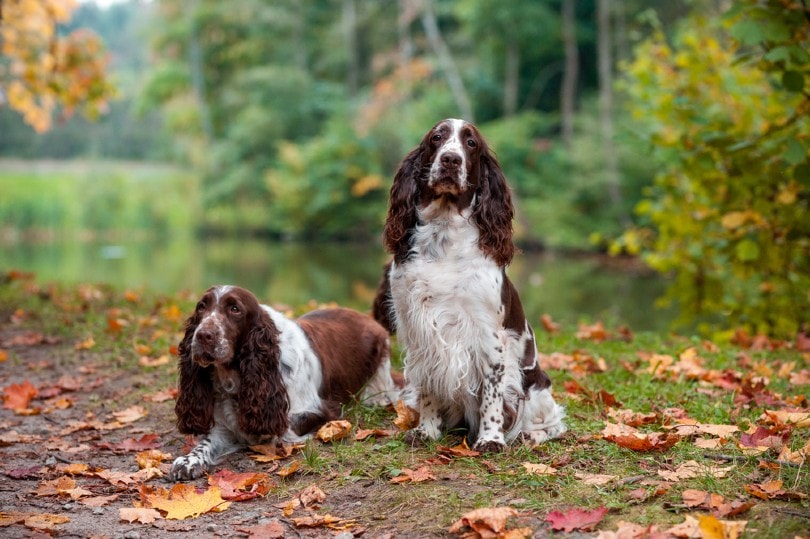
Health & Care
Springer Spaniels are typically long-lived dogs and quite healthy. However, they can suffer from several common dog health issues, including hip and elbow dysplasia, eye conditions, and ear problems. Springer Spaniels can also become obese due to their interesting habit of matching the energy level of their master. They have sensitive skin, and care must be taken to ensure it doesn’t become inflamed or otherwise irritated. Lastly, this breed is prone to several types of heart disease, including patent ductus arteriosus (PDA).
Grooming Needs
Ensure you have a good brush handy because your Springer Spaniel will need it several times a week. They shed all year (and quite a bit). The more frequently you brush them, the less hair you’ll find in your home. As with all dogs, brushing your Springer Spaniel’s teeth two to three times a week is recommended. You must also check their ears bi-weekly and ensure they stay clean. Also, your Springer Spaniel will likely need a bath about once every 6 weeks, but it depends on how often they go outside.
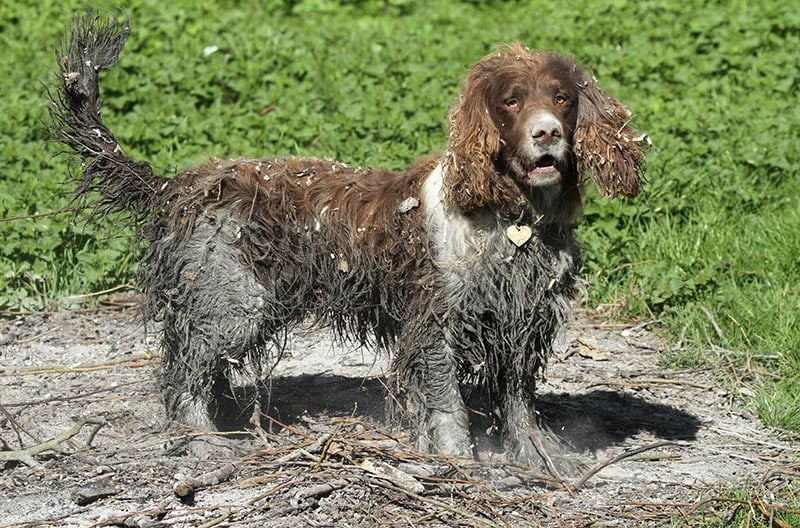
Exercise Needs
Because they’re so full of energy, a Spring Spaniel will need at least 2 hours of exercise every day to stay fit, happy, and healthy. Two long walks and frequent visits to your local dog park are excellent daily activities. Swimming is also a great way to give your pet the exercise it needs, and most Springer Spaniels will be thrilled to swim in a lake, stream, or ocean.
Suitable For:
When socialized well, the Springer Spaniel will make a wonderful pet for families large and small. These dogs will thrive with a more energetic and active owner who can give them several hours a day of attention, activity, and mental stimulation. Because of their boundless energy, keeping a Springer Spaniel in an apartment is not recommended. However, it should be possible if a large green space is available nearby. One last note is that if you spend a lot of time away from home, a Springer Spaniel might not be a good choice since they like to be near their humans all the time.
- Easy to train
- Great with children and other dogs
- Not too big but not small
- Energetic and playful
- Family-friendly
- Highly adaptive
- Beautiful dogs
- Can suffer separation anxiety
- High prey drive
- Too smart for their own good
- Need a lot of physical and mental stimulation
- Shed a lot
Cocker Spaniel Overview

Personality / Character
Known as gentle and laid-back dogs once they’ve matured, Cocker Spaniels are wonderful with children and unusually friendly with strangers, which unfortunately makes them poor watchdogs. Like the Springer Spaniel, the Cocker thrives on human attention and will seek it out if not given. They love being around their favorite people, and it shows.
Training
Since they’re intelligent and quick-witted, Cocker Spaniels are one of the easier breeds to train, but there are anecdotal reports of them being stubborn. You must begin training your pet early to prevent unwanted behavior problems later in life. Positive reinforcement is a must since Cockers are sensitive dogs that respond poorly to negativity.
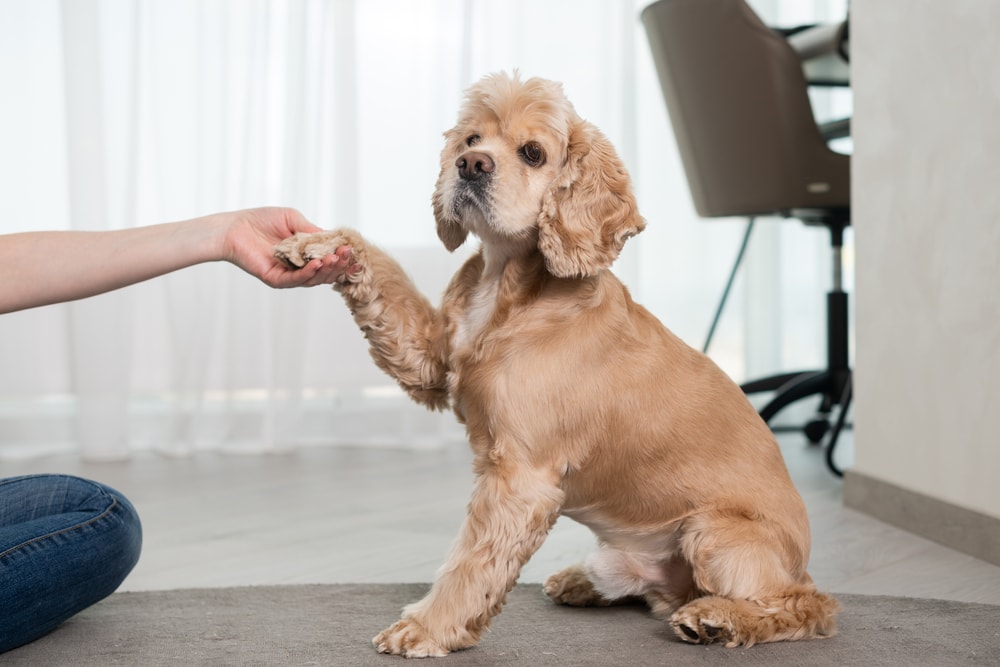
Health & Care
Although they tend to live long lives, the Cocker Spaniel suffers from various health issues. One of the worst is intervertebral disc disease (IVDD), when the discs in a Cocker’s low back degenerate, leading to paralysis of their hind legs. Elbow dysplasia and patellar luxation can also affect Cockers. Lip fold dermatitis, referred to as “cocker mouth,” is a frequent Cocker Spaniel health issue. Glaucoma is a common issue but usually doesn’t begin until much later in a Cocker’s life. Lastly, their beautiful floppy ears make ear issues and infections common in Cockers.
Grooming Needs
Like their Springer Spaniel cousins, the Cocker Spaniel needs a lot of grooming. Brushing their coats daily is a must for most, or they’ll get covered in tangles and mats. If yours is used for hunting (and even if it’s not), bi-weekly baths will probably be necessary. It’s also critical to learn how to clean and dry your Cocker’s long, luxurious ears.
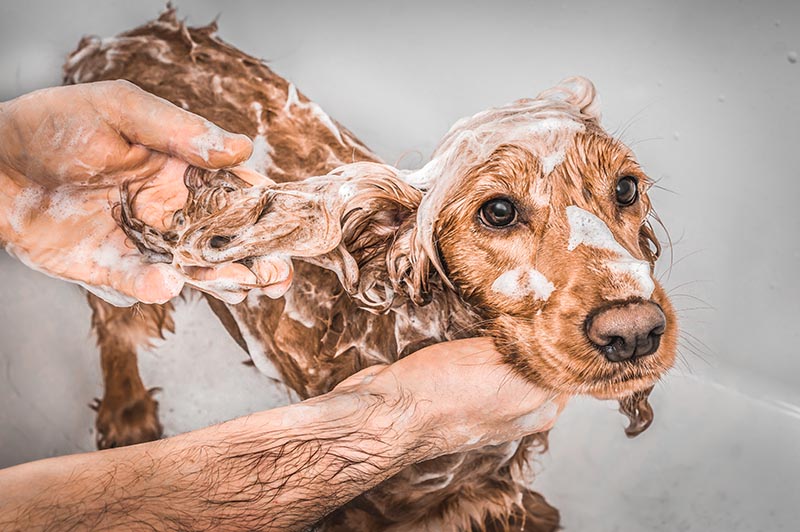
Exercise Needs
Although they need exercise to maintain their health, Cocker Spaniels need less than their Springer Spaniel cousins. A long walk every day combined with some play time at home will suffice. Cockers love to play fetch, and having a big yard is a plus. Since they get along well with other dogs, a trip or two per week to your local dog park is a great idea. Like their canine cousins, the Cocker has a bad habit of matching the energy level of their owner, making obesity a concern.
Suitable For:
Like the Springer, the Cocker Spaniel gets along with almost everyone and is a great choice as a family dog. They’re also a good choice for seniors and singles, as they don’t need as much exercise or space to run around. Since they often get along well with children, Cockers are ideal for young families, but it’s best to socialize them as puppies to reduce their prey instincts.
- People pleasers
- Easy to train
- Very intelligent (#20 among all dogs)
- Excellent family pets
- Friendly and affectionate
- Highly adaptable
- Prone to severe separation anxiety
- High-maintenance grooming needs
- Prone to ear infections
- Aggressive about food
- Problems with potty training
Springer Spaniel vs. Cocker Spaniel – Separation Anxiety
The Springer and Cocker Spaniel have problems being alone. This, unfortunately, can lead to separation anxiety in both breeds, although it seems the Cocker is more affected than the Springer Spaniel by this issue. It’s worth noting that, with either dog, a stay-at-home owner is best.

Springer Spaniel vs. Cocker Spaniel – Size
One of the biggest differences between these similar dog breeds is their size and weight. While the Cocker Spaniel can be considered a small-to-medium-sized dog (males weigh about 30 pounds), an adult Springer Spaniel male can tip the scales at around 50 pounds. Also, Springer Spaniels stand about 20 inches tall, while Cockers are around 15 inches.
Which Breed Is Right for You?
The choice between these two beautiful breeds is a tough one. One factor that might help is whether you need a companion pet or a pet and working dog, in which case the Springer Spaniel might be the better choice. Cocker Spaniels are admittedly more popular but have a higher incidence of separation anxiety.
If a smaller dog is what you wish, the Cocker is the more compact of the two breeds, but the Springer Spaniel is by no means a giant. What it boils down to, in most cases, is your personal preference. Whichever of these two fine canines you choose, if you raise and train it well, you’ll have a loyal friend and a wonderful pet.
Related Reads:
- English vs American Cocker Spaniel: Key Differences (With Pictures)
- Cavalier King Charles Spaniel vs King Charles Spaniel: The Differences (With Pictures)
Featured Image Credit: Top – Kevinsphotos, Pixabay | Bottom – Véronique Nijs, Pexels

